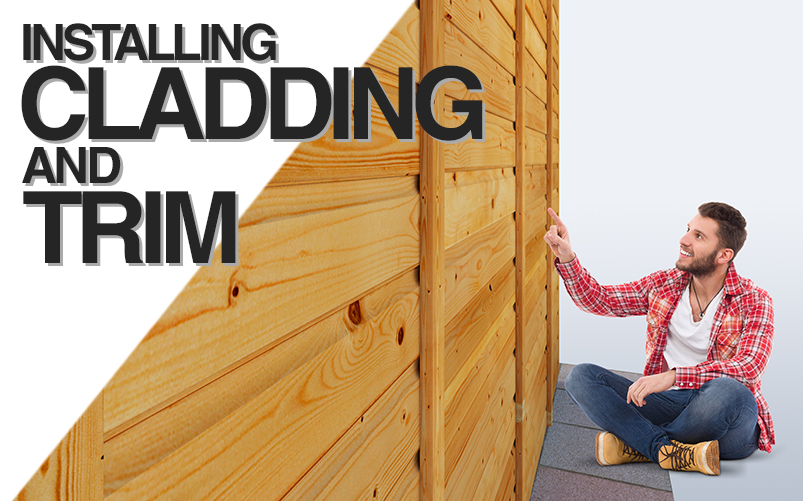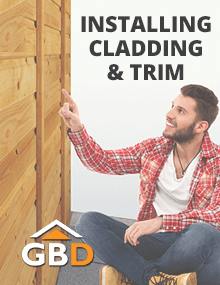
Keep scrolling to learn all you need to know about cladding for garden sheds and buildings.
Shiplap Cladding
Shiplap cladding offers the visual appeal of overlap cladding whilst providing the strength and durability of tongue and groove cladding. It is considered a good option for a backyard or garden shed because it will last for quite some time. Shiplap cladding is watertight, and water actually run off the sides of the shed more effectively.
For the wood treatment, many experts recommend using a spirit-based treatment for cladding. This type of treatment actually sinks into the wood used instead of sitting on the surface, providing better protection. Water-based treatments can be used with shiplap cladding, but they may need to be re-applied annually.
Installation Resources
Guides
- 5 Advantages of Using Shiplap Siding
- Cladding Installation
- External Cladding Methods
- How to Install Shiplap
Videos
- How To Install Shiplap Siding
- How To Fit Shiplap Wall Cladding
- DIY Shiplap Wall – How To Install Shiplap
- Horizontal Cladding installation video
- Installing a shiplapped ceiling
Overlap Cladding
Overlap cladding is another example of shed cladding types. It makes use of overlapping boards to create the shed’s side panels. By overlapping the boards, the shed is well protected from the elements. This form of timber cladding creates a durable building that is also very cost-effective. However, this type of cladding may warp if the shed is placed under direct sunlight much of the day. It also makes it more difficult to install shelving or hang items on the interior of the shed.
For treatment, a good option here is to use a spirit-based treatment. Water-based treatments can be used to add colour to the shed, but they may need to be re-applied every year.
Installation Resources
Guides
- Fixing horizontal cladding/weatherboard
- How to Install Lap Siding | Home Tips
- Installing Horizontal Wood Lap Siding
- Step-By-Step Wood Siding Installation
- How to Hang Clapboard Siding
Videos
- Installing Clapboard Siding and Exterior Trim
- How to Replace Damaged Wood Lap Siding
- How to install Bevel Siding
- How To Install Lap Siding
- Siding Installation
Tongue and Groove Cladding
Tongue and Groove cladding amounts to boards that interlock, used in many of our best-sellers. The tongue on the one edge of the board slides into the groove on the edge of the adjoining board, locking together to create a strong, durable surface. These type of shed cladding panels are very strong and watertight, plus they are stronger than other types of cladding. Tongue and groove cladding also provides extra protection against the elements and constant use. On the downside, rainwater doesn’t run off the sides as well as it does with shiplap cladding. That’s why we use it in a number of our Shed and Log Cabin ranges, including:
- 11mm Sheds
- 19mm Log Cabins
- 28mm Log cabins
- 44mm Log Cabins
- All the way up to 66mm
Like the other two types of composite cladding, a good option here is to use spirit-based treatments. Water-based treatments may need to be applied yearly, although they do offer a variety of colour options.
Installation Resources:
Guides
- Tongue and groove wall panelling | DIY Tips
- Fit Tongue and Groove Wooden Cladding
- Installing Tongue-and-groove Siding
- Installing tongue and groove siding
- How to Install Tongue and Groove Siding
Videos
- BillyOh – The Benefit Of Tongue & Groove Cladding
- How to install Tongue and Groove Cladding
- Curb Appeal: How To Install Exterior Wood Siding
- Installing tongue and groove walls
- Tongue and Groove Panelling Install Video
How to Trim a Shed
Trimming a shed is what gives it character. Most sheds that are clad in wood require trim around doors, windows, corners, roof soffit and fascia. Trim helps to seal corner and roof joints and improves a shed’s appearance.
Step 1 How to install eave fascia
Step 2 How to Install Rake fascia
Step 3 How to Install Shed Roof Soffit
Step 4 How to install corner trim
Step 5 How to Trim a Shed Door

